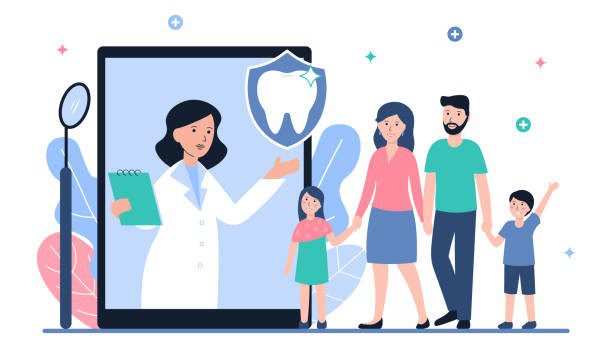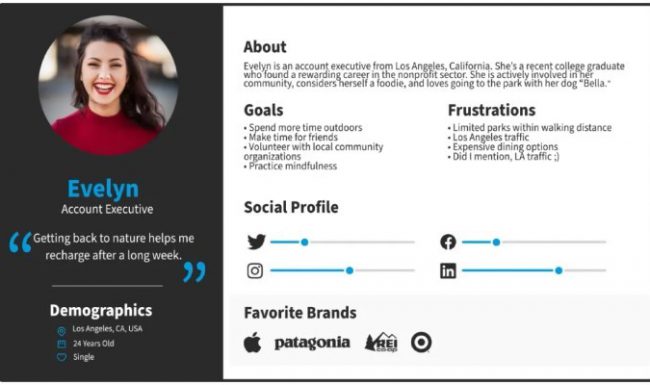
As a dental practice owner, you already know how crucial it is to attract and retain patients. That’s where knowing your dental personas and optimizing your website to address their needs comes into play.
A study by Econsultancy found that 80% of consumers are more likely to do business with a company that offers personalized experiences.
User personas are fictional, yet realistic, representations of your ideal patients, created based on research and data about your target audience. They help you understand your patients’ needs, preferences, and behavior, enabling you to:
According to a study by Salesforce, 84% of customers say being treated like a person, not a number, is very important to winning their business. User personas can help you achieve this level of personalization on your dental website.
User personas are crucial in the dental industry because they help you understand your patients on a deeper level.
By creating detailed profiles of your target audience, you can tailor your marketing efforts to better address their needs, wants, and pain points.
This targeted approach leads to higher engagement, conversions, and ultimately, a more successful dental practice.
For instance, according to HubSpot, companies that use personas in their marketing campaigns have a 73% higher conversion rate than those that don’t.
That’s a powerful stat that underscores the value of user personas in the dental industry!
User personas don’t just improve your marketing campaigns; they also have a significant impact on patient satisfaction.
When you understand your patients’ unique needs, you can personalize their experience, making them feel valued and heard.
By using user personas in your dental marketing, you’re not only attracting new patients but also keeping existing ones happy and loyal.
The buyer’s journey is the path a patient takes from becoming aware of your dental practice to scheduling an appointment.

By incorporating user personas and buyer journey strategies into your dental website, you can:
According to a study by Accenture, 91% of consumers are more likely to shop with brands that provide relevant offers and recommendations. (buyer’s journey)
This demonstrates the power of personalization, which can be achieved through the use of user personas and buyer’s journey strategies.
This comprehensive guide will cover everything you need to know about user personas and buyer’s journey strategies for dental websites, including:
By the end of this guide, you’ll have a solid understanding of user personas and buyer’s journey strategies, and how to effectively apply them to your dental website to attract and retain more patients.

Step 1: Gather data from existing patients through surveys, interviews, and website analytics.
Step 2: Analyze the data to identify patterns and trends among your patients.
Step 3: Segment your patients into groups based on similarities in demographics, psychographics, and behavior.
Step 4: Create detailed descriptions of each group, including a fictional name, background, and story.
Let’s look at three examples of dental patient personas:



By creating dental patient personas like these, you can better understand your audience and tailor your dental website to meet their needs and expectations.

To create effective user personas for your dental website, you’ll need to gather accurate data.
Here’s a step-by-step guide on how to find the right information, conduct surveys and interviews, and analyze the data to build your user personas.
Remember to keep your personas realistic and specific, and use the data you’ve collected to back up your claims. By following these steps, you’ll be able to create user personas that accurately represent your patients and help you tailor your dental website to their needs.

Creating user personas is a crucial step in understanding your dental patient marketing strategy, but it’s easy to make mistakes that can undermine their effectiveness.
Here are three common pitfalls to avoid when developing user personas, along with tips on how to sidestep them.
Mistake: Creating overly broad user personas that don’t accurately represent your patients or relying on stereotypes to describe them.
Solution: Use specific and realistic details to create your personas. Base your descriptions on actual data collected from patient records, surveys, interviews, and online reviews. This ensures that your personas accurately reflect your patient base and helps you avoid harmful stereotypes.
For example, instead of creating a generic “middle-aged man” persona, create a persona like “Active Senior Sam,” who’s a 65-year-old retiree that enjoys playing golf and seeks dental care for his aging teeth.
Mistake: Concentrating solely on demographics (age, gender, income) and neglecting psychographics (values, attitudes, interests) and behavior (how patients interact with your practice).
Solution: Incorporate a mix of demographics, psychographics, and behavioral data into your personas. This will help you understand not only who your patients are but also what motivates them and how they make decisions related to dental care.
For example, explore factors like their dental health goals, communication preferences, and how they search for a dentist.
Mistake: Creating user personas in isolation, without input from your dental practice’s staff or patients.
Solution: Involve your team and patients in the persona development process. Interview staff members to gain insights into patient needs, preferences, and behaviors. Collect feedback from patients through surveys, interviews, or informal conversations. By incorporating these perspectives, you’ll create user personas that are more accurate, relevant, and valuable to your practice.
By avoiding these common mistakes, you’ll create user personas that are more effective in guiding your dental website’s design, content, and overall user experience.

Creating effective user personas can help you better understand your dental patients and tailor your website to their needs.
Here are some best practices to follow when developing user personas for your dental practice.
Step 1: Base your personas on real data collected from patient records, surveys, and interviews.
Step 2: Include demographics (age, gender, income), psychographics (values, attitudes, interests), and behavioral data (how patients interact with your practice) in your personas.
Step 3: Give each persona a name, photo, and backstory to make them relatable and memorable.
Step 4: Focus on the most common and relevant patient types for your practice, aiming for 3-5 personas.
Example: “Busy Mom Maria,” a 35-year-old working mother who values convenience and seeks a family-friendly dental practice with flexible scheduling options.
Step 1: Create an empathy map for each persona, divided into sections like “Think & Feel,” “Hear,” “See,” and “Do.”
Step 2: Fill out each section based on what your patients might think, feel, hear, and see, as well as how they act in specific situations.
Step 3: Use insights from your empathy maps to identify patient pain points and opportunities to improve their experience with your dental practice.
Example: For “Busy Mom Maria,” you might learn that she feels stressed about juggling work and family commitments and would appreciate appointment reminders via text message.
Step 1: Share your personas with your dental practice team and gather feedback on their accuracy and relevance.
Step 2: Conduct interviews or surveys with patients to confirm that your personas resonate with their real-life experiences.
Step 3: Continually refine your personas based on new data and insights, and revalidate them periodically to ensure they remain relevant as your patient base evolves.
By following these best practices, you’ll create user personas that help you better understand your dental patients and inform your website design, content, and user experience.

Remember, a clear purpose is essential for creating targeted, effective marketing campaigns. So, let’s start by defining your goals and objectives for your user personas.
By aligning your user personas with your practice’s goals and focusing on key segments, you’ll boost the effectiveness of your marketing efforts. Now, let’s connect your personas to your services.

Now we’ll discuss how to connect your personas with your dental services. By matching personas with specific treatments and tailoring your communication, you’ll create more effective, targeted marketing campaigns.
Example: Take Sarah, the busy working mom. As she values convenience and efficiency, she might be drawn to services like same-day crowns or family block appointments.
Example: To resonate with Sarah, use messaging that highlights your practice’s flexible scheduling options and family-friendly environment.
A study by Aberdeen Group found that personalized marketing messages can improve click-through rates by 14% and conversion rates by 10%.
Connect your personas with your dental services and tailor your communications to that persona to create more effective dental marketing campaigns & more helpful & user friendly website copy.
Speaking of websites, it’s time to use your patient profiles/personas to optimize the copy on your dental website.

User personas are essential tools for optimizing your dental website to attract and engage your target patients.
According to a study by Econsultancy, 94% of marketers believe personalization is critical to their success. By optimizing your dental website for each persona, you’ll create an engaging, effective online presence that drives results.
Here’s how you can apply these personas to enhance your website’s design, content, and user experience.
Step 1: Review your user personas and identify their key preferences, needs, and expectations when interacting with a dental website.
Step 2: Design your website with these insights in mind, creating clear navigation and a visually appealing layout that caters to your personas’ preferences.
Step 3: Make essential information, like contact details and services, easily accessible to address the needs of your target patients.
Example: For “Busy Mom Maria,” ensure your website has a responsive design for easy browsing on mobile devices and prominently features online appointment scheduling.
Step 1: Persona-Specific Content: Develop content that speaks directly to each persona’s needs, goals, and challenges. This might include blog posts, videos, or testimonials from patients with similar backgrounds or concerns.
Example: Write a blog post about “Top Tips for Making Dental Appointments Stress-Free for Busy Moms,” addressing Maria’s concerns about balancing family and dental care.
Step 2: Personalize Your Language: Use language and tone that resonates with each persona. This helps visitors feel understood and makes your website more engaging.
Step 3: Utilize SEO: Incorporate keywords with high search volumes relevant to each persona in your content to improve search engine rankings. Use tools like Google’s Keyword Planner to find the best keywords for your target audience.
Step 4: Offering solutions tailored to each persona (see previous section: Connecting Personas with Your Dental Services)
Step 1: Review your website’s user experience through the lens of your personas, ensuring that it meets their expectations and addresses their pain points.
Step 2: Optimize website elements like load times, mobile responsiveness, and accessibility to create a smooth experience for all your personas.
Step 3: Organize your website’s menu and layout to make it easy for different personas to find the information they need. Consider adding dropdown menus or filters for specific services or treatments.
Step 4: Create CTAs tailored to each persona’s needs and pain points. For example, a working parent might appreciate a “Book a Family Appointment” CTA, while a young professional might prefer “Schedule a Teeth Whitening Consultation.”
Step 5: Monitor user behavior and feedback to identify areas for improvement and refine your website’s user experience over time.
Example: Simplify appointment scheduling for “Busy Mom Maria” by offering a user-friendly online booking system and sending appointment reminders via text message.
By applying user personas to your dental website’s design, content, and user experience, you can create a more personalized, engaging, and effective platform that meets the needs of your target patients.

Here you’ll learn how to leverage social media and online marketing for each persona. By crafting targeted ads and engaging with your audience, you’ll create a strong online presence that attracts new patients.
According to a study by Social Media Examiner, 89% of marketers find social media effective in increasing brand exposure.
By leveraging social media and online marketing for each persona, you’ll expand your reach and attract more patients to your dental practice.
In the next section, we’ll discuss how to track and measure the success of your user persona strategy. Keep up the amazing work, and let’s continue honing those user personas!

It’s time to explore how to adapt your user personas for various marketing channels. We’ll discuss email marketing, direct mail, and other outreach strategies, ensuring consistent messaging across all channels. Let’s get started!
To make your email marketing persona-driven, follow these steps:
Just like email marketing, direct mail can benefit from a persona-driven approach:
To maintain a unified brand presence, keep your messaging consistent across all channels:
By adapting user personas for different marketing channels, you’ll create a cohesive and targeted marketing strategy that resonates with your audience. Keep up the great work, and watch your dental practice grow!

Typically, 3 to 5 personas are sufficient to cover most of your target audience. However, this may vary depending on your practice’s specific needs and offerings. The key is to strike a balance between being inclusive and not overwhelming your marketing efforts.
Absolutely! As your practice grows and evolves, so will your audience. It’s important to review and update your personas regularly, taking into account new insights and trends to ensure they remain relevant.
Encourage staff to share their insights and experiences with patients. Hold workshops or brainstorming sessions where everyone can contribute ideas. This collaboration will help create more accurate and well-rounded personas and buyer journeys.
Track metrics like website engagement, conversion rates, and patient satisfaction to gauge the effectiveness of your strategies. Use tools like Google Analytics to monitor progress and make data-driven decisions.
Remember, the goal is to create a more personalized experience for your patients, so don’t be afraid to ask for their feedback and make adjustments as needed.

We’ve come a long way in this guide, diving deep into the world of user personas and buyer’s journey strategies.
So, why are user personas essential for your dental practice?
Now it’s time to take action!
Remember, the journey to success begins with understanding your patients and their needs. Let’s work together to create a dental website experience that exceeds their expectations and sets your practice apart.
With our help, you can unlock your practice’s full potential and create a truly patient-centered experience that will keep your them coming back.
Reach out to Prosites for expert assistance in creating a powerful website that your patients will love.